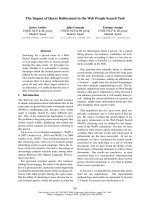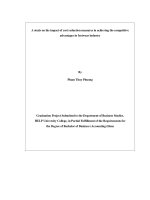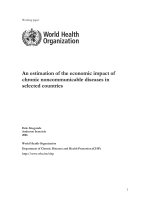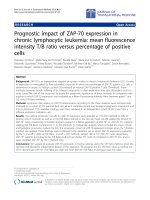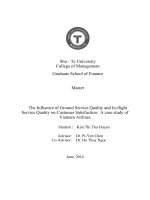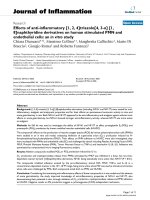Impact of customer verbal aggression on employee emotional exhaustion and turnover intention an emprical study of ground service staff in vietnamese aviation industry
Bạn đang xem bản rút gọn của tài liệu. Xem và tải ngay bản đầy đủ của tài liệu tại đây (948.39 KB, 90 trang )
UNIVERSITY OF ECONOMICS HO CHI MINH CITY
International School of Business
----------------------------
Nguyen Tran Thuy Trang
IMPACT OF CUSTOMER VERBAL
AGGRESSION ON EMPLOYEE EMOTIONAL
EXHAUSTION AND TURNOVER INTENTION:
AN EMPIRICAL STUDY OF GROUND SERVICE
STAFF IN VIETNAMESE AVIATION INDUSTRY
MASTER OF BUSINESS (Honours)
Ho Chi Minh City – Year 2015
UNIVERSITY OF ECONOMICS HO CHI MINH CITY
International School of Business
----------------------------
Nguyen Tran Thuy Trang
IMPACT OF CUSTOMER VERBAL
AGGRESSION ON EMPLOYEE EMOTIONAL
EXHAUSTION AND TURNOVER INTENTION:
AN EMPIRICAL STUDY OF GROUND SERVICE
STAFF IN VIETNAMESE AVIATION INDUSTRY
ID: 22130082
MASTER OF BUSINESS (Honours)
SUPERVISOR: Dr. NGUYEN THI NGUYET QUE
Ho Chi Minh City – Year 2015
ACKNOWLEDGEMENT
Firstly, I would like to express my great gratitude to my supervisor, Dr. Nguyen
Thi Nguyet Que for her kindness, professional guidance and encouragement as well as
dedicated support, valuable comments, instructions through my thesis.
Secondly, I am sincerely thankful to Professor Nguyen Dinh Tho, Dr. Nguyen
Thi Mai Trang, and Dr. Tran Ha Minh Quan as proposal examination committee. Their
comments and meaningful suggestions significantly contribute to this research
completion.
Finally, my special gratitude is extended to all instructors and staffs of
International School of Business – University of Economics Ho Chi Minh City for their
teaching and guidance during my master course.
i
ABSTRACT
The purpose of this research is to investigate the impacts of customer verbal
aggression to emotional exhaustion and turnover intention of ground service staff in
Vietnam aviation industry. This research framework was tested through a survey on
employees from ground customer service in Noi Bai International Airport, Da Nang
International Airport, and Tan Son Nhat International Airport. The findings of this
research showed significant and positive effects of customer verbal aggression on
emotional exhaustion and turnover intention. Furthermore, the research found that
customer verbal aggression positively relates on stress appraisal; negative affectivity
positively relates to customer verbal aggression and stress appraisal of customer verbal
aggression, as well as stress appraisal of customer verbal aggression positively relates
to turnover intention. Employee emotional exhaustion still has the significance to
turnover intention. These findings suggest that the organization should consider and
encourage employees’ spirit to be motivated and inspired in their job. Additionally, the
organization should have solution to minimize the verbal attack of customers to
employees.
Key words: customer verbal aggression, negative affectivity, stress appraisal,
emotional exhaustion, turnover intention
ii
LIST OF ABBREVIATIONS
IATA: International Air Transport Association
EFA: Exploratory Factor Analysis
CFA: Confirmatory Factor Analysis
SEM: Structural Equation Modeling
CVA: Customer verbal aggression
EMO: Emotional exhaustion
TOI: Turnover intention
NEG: Negative affectivity
STRESS: Stress appraisal
SPSS: Statistical Package for Social Science
AMOS: Analysis of Moment Structure
AVE: Average Variances Extracted
iii
LIST OF TABLES
Table 3.1: In-depth interview respondent information ........................................... 26
Table 4.1: Source of data collection ....................................................................... 31
Table 4.2: Sample characteristics ........................................................................... 32
Table 4.3: Reliability test results after deleting items NEG1 and NEG2 ............... 33
Table 4.4: KMO & Barlett’s test ............................................................................ 33
Table 4.5: KMO & Barlett’s test after deleting EMO2 & EMO3 .......................... 34
Table 4.6: Rotated component matrix after deleting EMO2 & EMO3 .................. 35
Table 4.7: Reliability test results of new variables ................................................ 36
Table 4.8: Standardized regression weights ........................................................... 38
Table 4.9: The first AVE ........................................................................................ 39
Table 4.10: The second AVE ................................................................................. 39
Table 4.11: Regression weights .............................................................................. 42
Table 4.12: Standardized regression weights (bootstrap method error)................. 43
iv
LIST OF FIGURES
Figure 1.1: Vietnam aviation labor structure .......................................................... 2
Figure 1.2: Vietnam aviation educational labor standard....................................... 3
Figure 3.1: Research process .................................................................................. 21
Figure 4.1: CFA of 05 constructs ........................................................................... 37
Figure 4.2: Second CFA after deleting CVA3 and CVA7 ..................................... 40
Figure 4.3: Structural results .................................................................................. 41
Figure 4.4: Final model after testing ...................................................................... 52
v
TABLE OF CONTENTS
ACKNOWLEDGEMENT ....................................................................................................... i
ABSTRACT ............................................................................................................................. ii
LIST OF ABBREVIATIONS ................................................................................................ iii
LIST OF TABLES .................................................................................................................. iv
LIST OF FIGURES ................................................................................................................. v
CHAPTER ONE: INTRODUCTION.................................................................................... 2
1.1
Research Background ································································································· 2
1.2
Research Problem ······································································································· 6
1.3
Research Objective and Research Questions ······························································ 8
1.4
Research Methodology and Scope ·············································································· 9
1.5
Research Significance ································································································· 9
1.6
Structure of the research ··························································································· 10
CHAPTER TWO: LITERATURE REVIEW .................................................................... 12
2.1
Review previous study ······························································································ 12
2.1
Hypotheses and Research Model Development ······················································· 18
2.3
Conceptual model ····································································································· 23
CHAPTER THREE: RESEARCH METHODOLOGY ................................................... 25
3.1 Research process ············································································································ 25
3.2 Measurement Scale ········································································································ 26
3.3. Questionnaire Design ···································································································· 29
3.4 Sample size and Sampling method ················································································ 34
3.5 Data Analysis Method ··································································································· 35
CHAPTER FOUR: DATA ANALYSIS ............................................................................. 38
4.1 Data Collection ·············································································································· 38
vi
4.2 Respondents’ Demographics ························································································· 38
4.2 Reliability Analysis········································································································ 39
4.3 Exploratory Factor Analysis ·························································································· 40
4.4 Evaluate the measurement by CFA ··············································································· 44
4.5 SEM Testing and Bootstrap Method ············································································· 48
4.6 Results of testing hypotheses ························································································· 51
4.7 Discussion of the hypotheses ························································································· 53
CHAPTER FIVE: CONCLUSION, IMPLICATION, AND LIMITATION ................... 56
5.1 Conclusion about hypotheses and research problem ····················································· 56
5.2 Research contribution ···································································································· 57
5.3 Limitation and future research ······················································································· 59
vii
CHAPTER ONE: INTRODUCTION
This is the opening chapter of the research. In this part, the overview of Vietnam
civil aviation and labor structure are described first. The second the author bases on the
reality of aviation labor resource to show the research problem, which is the author
would like to research in this thesis. Research objective, research questions, research
methodology and scope, research significance, and thesis structure are the next parts in
this chapter that the author presents to overview the content and assignment through the
thesis.
1.1
Research Background
1.1.1 About Vietnam Civil Aviation
For such countries, civil aviation is always amazed technical and economic
characteristics because it is application of scientific achievements in the most advanced
techniques. Civil aviation activities are not only economic in nature but also merely
closely related to security, national defense, and foreign economic relations. So far,
Vietnam civil aviation has made encouraging progress with reforms on the path of
modernization. In recent years, although the world economy passes the crisis and
recession period, overall still grows. Among them, the aviation traffic operation always
gets high speed. Especially, strong resurgence of the emerging economies in the AsiaPacific, including Vietnam as a basis for favorable forecast output growth of the aviation
sector.
The wings of Vietnam aviation today not only fly within domestic airport, but
also to many continents in the world with the new modern aircrafts. The airports have
more facilities for passengers, many terminals, runways, and aprons are extended.
Vietnam aviation market has achieved remarkable progress in the last five years the
average annual growth of 15%. According to figures reported by the Civil Aviation
Administration of Vietnam in 2010 - 2014, Vietnam Aviation Service continues to
maintain high growth rates. According to the International Air Transport Association
(IATA) in the period from 2013 to 2017, Vietnam aviation market is growing fast and
dynamic, ranked number seven among the fastest growing market world. In 2014, total
2
passenger transport market was estimated at 32 million passengers (up to 10.6%,
compared with 2013) and commodity markets estimated at 706 thousand tons (up to
12.6%, compared with 2013). In the period 2010 - 2014, the average growth rate of
passenger transport and freight transport respectively reached 12.4% and 14.6%.
Located in the region of Southeast Asia, Vietnam market witnessed strong demand
growth in operating passenger transport and freight, to promote the development of
aviation. According to the project "Master plan for Vietnam tourism development to
2020 and vision to 2030", by 2020, Vietnam will attract 10,5 million international
passengers, attend to 47.5 million domestic arrivals; by 2030, Vietnam will attract 18
million international tourists and 71 million domestic visitors. In 2020, the total revenue
from tourism reached 18,5 billion US dollars, accounting for 7% of GDP; 2030 reached
35,2 billion US dollars, accounting for 7.5% of GDP. Under the scheme, predicted the
tourism industry will achieve an average growth rate of over 30% in revenue and 20%
of passenger traffic.
1.1.2 Aviation Labor Structure
Along with the renewal of equipment is the progress on the management
capacity, professional skills, quality of service, and service style of management staff,
technicians, air traffic control, flight attendances, ground service staff, etc. They are
basic training or advanced training in domestic and foreign operations. The process of
integration and the development requires the mobilization and use of force is the total
resources, including in particular internal factors. In the internal factors, the human
factor is the decisive factor in the development of strong and sustainable, ensuring
competitiveness in the future. Therefore, Vietnam aviation industry has focused the
work of planning, training, and retraining of staff and workers under the program to
reach international standards. In addition to the academic programs in the country,
groups of airports was contracted trained, sent staff officers to study abroad, have access
to and learn technology, advanced science, apparel services unit.
As of December 2012, the aviation labor is 32,695 people with the following
structure:
3
Figure 1.1 Vietnam aviation labor structure
(Source: Civil Aviation Authority of Vietnam, 2012)
2%
19%
Administrative and Enterprise
Aviation business
79%
Others
The average age of employees is from 31 to 33, which under 30 is 37.3%, 3040 is 35.2%, 40-50 is 17.9%, and over 50 is 9.6%. Educational level of staffs is listed
below:
-
Postgraduate: 1020 people (3.1%)
-
University: 13,647 people (41.7%)
-
Intermediate: 6565 people (20.1%)
-
Primary and technical workers: 9737 people (29.8%)
-
Unskilled workers: 1726 people (5.3%)
4
Figure 1.2 Vietnam aviation educational labor standards
(Source: Civil Aviation Authority of Vietnam, 2012)
Unskilled workers Postgraduate
5%
3%
Primary and
technical workers
30%
University
42%
Intermediate
20%
It was found that the most education level of aviation employees is university with
high qualification. With the new fresh blood of the staff and high qualification, the future
of the aviation industry will increasingly develop and go further in the world. Although
the quality employees is increasing, aviation labor shortage still occurs and it is
considered a difficult problem for the managers. As of now, the units, organizations, or
companies operating in the sector of civil aviation recruit thousands of employees each
year to ensure the stability of its operating units. The percentage of turnover, “switch
job” of aviation labors have tended to rise faster and higher at an alarming rate.
According to Civil Aviation Authority of Vietnam in the last few years, the turnover
rate ranged from the average 20% to 40% per year. Particularly, this ratio is as high as
in the stitching units of air traffic or airport corporation operation that directly relevant
parts and play a key role in the activities of civil aviation sector. According to the report
from Civil Aviation Authority of Vietnam (2012), ground service staff is a part of air
traffic and one of the sectors has high turnover rate. The airlines recruit ground service
staff twice each year because of the shortage of employees compared to the operation
5
scale of the civil aviation sector is growing. This is really a concern of managers for the
stable operation of civil aviation sector.
1.2
Research Problem
The employees’ turnover rate or the employees who change jobs are increase;
the morale and productivity of other employees are affected. At the same time, the units
of field take many times and money for recruiting and training the new employees. There
are many reasons why the employees leave: low salaries, overworked, lack of
motivation, lack of training, or lack of reward and recognition, etc. One of the reasons
that more and more appear recently, impact to the psychological of customer service
employees is the customer verbal aggression. It not only makes the employees feel
tension, but also they are not motivated to continue their job. Aquino – Nemecek, a
director of the United Airlines Red Carpet Club in Los Angeles, said, “Working in the
customer services department for an airline is “the worst place to work” as there is not
a day that goes by without a passenger complaining. Customers want the airline
employees to listen to whatever is irritating them. Sometimes, passenger rude behavior
is just too much. They push; even hit the airline staff when they feel angry”.
According to specific tasks such as ground service staff, capable of frequent
exposure to different passengers coming from different countries require the staffs more
knowledge and skills with the best and professional service style. The pressure from
work requirements and customer satisfaction make aviation employees depressed. In
particular, the passengers who have bad attitudes with verbal aggression will cause the
hurt to the self-esteem of employees. The customers use heavy words to criticize or even
insult the aviation employees take place more and more. These cause negative affectivity
such as distressed, irritable or upset for the staffs; they will have bad mood and no
motivation in their job. The attack of passengers to aviation staff appear in the press
many times. Example: Chau Nhu Quynh (Dan Tri News, 2015) reported that one woman
was banned 7 millions VNĐ because of hitting one-man aviation staff. The reason for
this action was the woman did not want to pay crib free. On the other hand, T. Ha (Nguoi
Lao Dong News, 2015) reported, one passenger hit the aviation staff because the staff
6
asked him to check the identity card. Many articles appeared in the newspaper to report
the assault of customer to employees. Mr. Lai Xuan Thanh, Director of Vietnam Civil
Aviation Authority said, “In the first 6 months of 2015, the transport of passengers by
airplanes was approximately 30 millions. Also during this period, there was 41 incident
of safety, aviation security. While technical problems reduced, the incidents involving
humans have increased sharply. More and more incidents happened because many
passengers did not read the regulations, or they grasp the rules of the airline industry but
deliberately ignored. Many passengers were cursing, assaulting, threatening staff
procedures being prompt for violating regulations”. The pressures from high
requirement of the job, coupled with pressure from customers make employees feel
stress. Since then, they decide to leave the organization and find another job, which
make them feel better.
Some researches of foreign authors mentioned and studied about the impact of
customer verbal aggression to employees, such as:
“Influence of customer verbal aggression to turnover intention” (Xiaoyan Li and
Erhua Zhou, 2013)
“The customer is not always right: customer aggression and emotion regulation
of service employees” (Grandey et al., 2004)
“Outcomes of customer verbal aggression among hotel employees” (Osman M.
Karatepe, Ilkay Yorganci and Mine Haktanir, 2009)
“Frontline service employees’ customer-related social stressors, emotional
exhaustion, and service recovery performance: customer orientation as a moderator”
(Taegoo Terry Kim, Soyon Paek, Chang Hwan Choi, and Gyehee Lee, 2012)
“Coping with customer aggression”(Ruhama Goussinsky, 2012)
Indeed, Dormann and Zapf (2004) stated that customer abusive behavior is
considered a major source of stress for service workers. However, only very few studies
have attempted to investigate the buffering role of organizational or personal resources
against the negative influence of being subjected to frequently abusive and hostile
behavior from customers. Additionally, these studies are focus on the call center
7
employees, hotel employees or general service employees (including airlines
employees). The domestic and overseas researches about customer verbal aggression to
ground service staffs in aviation are rare to find out. The majority studies about aviation
employees in Vietnam mention about the factors to affect the turnover rate are from
organization, not from customers.
From these facts, the study is conducted to clarify the effects of customer verbal
aggression to emotional exhaustion and turnover intention of ground service staff in
Vietnam aviation, along with negative affectivity and stress appraisal factors. Since
then, offering the solutions to overcome and minimize the extent of that influence.
1.3
Research Objective and Research Questions
Research Objective
To examine the impact of customer verbal aggression on employee emotional
exhaustion and turnover intention, the research focuses on the employees who working
as the ground service in Tan Son Nhat International Airport, Da Nang International
Airport, and Noi Bai International Airport.
Research Questions
-
Is there a significant effect of customer verbal aggression on stress appraisal
of customer verbal aggression?
-
Is there a significant effect of negative affectivity on customer verbal
aggression?
-
Is there a significant effect of negative affectivity on stress appraisal of
customer verbal aggression?
-
Is there a significant effect of customer verbal aggression on employee
emotional exhaustion?
-
Is there a significant effect of stress appraisal of customer verbal aggression
on employee emotional exhaustion?
-
Is there a significant effect of customer verbal aggression on turnover
intention?
8
-
Is there a significant effect of employee emotional exhaustion on turnover
intention?
-
Is there a significant effect of stress appraisal of customer verbal aggression
on turnover intention?
1.4
Research Methodology and Scope
Research Methodology
The research method combines qualitative and quantitative research; it helps
develop the accuracy and sufficiency of the research. Qualitative research collects the
ideas and opinions allow the adjustment of the study is made. While quantitative
research guarantees many people take the survey and allow the author to carry out the
data analysis with more reliable results. Statistical Package for the Social Science
software (SPSS) and Analysis of Moment Structure (AMOS) are the effective tools to
analyze the data; they are used in the data analysis chapter. The steps are to test the
reliability of the scales (Cronbach’s Alpha), Exploratory Factor Analysis. Finally, the
CFA is used to test the validity, while SEM is used to examine the hypothesized model.
Research Scope
This study is to research the impact of customer verbal aggression to the
emotional exhaustion and turnover intention in aviation industry, especially in ground
service staff. The survey will be conducted only through Facebook Messenger and
directly deliver to aviation employees in Vietnam only. Due to limited time, the
researcher only focuses on two main kinds of service staff are check-in agent and
passenger service agent. People whom response the questionnaire mostly come from Ha
Noi, Da Nang and Ho Chi Minh City. In Ha Noi and Da Nang, the questionnaire survey
will sent by Facebook Messenger because of the distance. In Ho Chi Minh City, the
paper survey will be directly delivered to employees in Tan Son Nhat International
Airport.
1.5
Research Significance
According to the findings in the end of this research, the author hopes to provide
a general outlook about influence of customer aggression to emotional exhaustion and
9
decision to quit job of ground service employees. Based on those, the organization as
well as the managers has more detail vision about the popular problem nowadays.
Additionally, they can understand factors to relate with customer verbal aggression as
negative affectivity and stress appraisal. Since then, the managers will have solutions to
retain their employees and reduce the bullying situation of passengers to aviation
employees.
On the other hand, this research is also vital for appropriate policy
implementation as issue the punishment of cursing, assaulting, and threatening aviation
employees. By having a good understanding about factors that have influence of
customer verbal aggression on emotional exhaustion and turnover intention, the
government can easily have policies to protect the employees and reduce turnover rate,
which is increasing sharply.
1.6
Structure of the research
The research includes five parts:
Chapter 1: Introduction
This chapter introduces the research background as well as research problems,
research objectives and questions, research methodology and scope, and research
significance.
Chapter 2: Literature Review and Hypotheses
This chapter presents literature reviews of customer verbal aggression,
employee turnover intention, stress appraisal, negative affectivity, and employee
emotional exhaustion. The hypotheses develop from these relationships.
Chapter 3: Research Methodology
Research process, measurement scales, questionnaire design, data collection
method, sampling design, and data analysis method are presented more details in this
chapter.
Chapter 4: Data Analysis
10
This chapter expresses all research results of the study. This is the most
important part of the research including Sample Descriptive Statistic, Reliability
Analysis, Exploratory Factors Analysis, CFA, and SEM. The discussion is also
represented in this chapter after having the results.
Chapter 5: Conclusions, Implication, and Limitation
Conclusions present a conclusion of the findings in the study, suggest
managerial implementations
based on the result of previous chapters, and give
limitations that impact on the finding as well as future direction.
11
CHAPTER TWO: LITERATURE REVIEW
This chapter mainly introduces the theories, which are proposed by many
scholars in academic field and are related to all the concepts and research model. At
first, the author introduces the definition of customer verbal aggression and turnover
intention. Next, the previous research of these concepts and their related discussion are
mentioned. Finally, based on these theories and the relation of previous research, the
hypotheses of relationship among these constructs and conceptual model are proposed.
2.1 Review previous study
2.1.1
Definition of main concepts
2.1.1.1 Turnover Intention
Employee turnover is the rotation of workers around the labor market; between
firms, jobs, and occupation; and between the states of employment and unemployment
(Abassi et al, 2000). The term “turnover” is defined by Price (1977) as the ratio number
of members who have left an organization during the period being considered divided
by the average number of people in that organization during the period. Frequently,
managers refer to turnover as the entire process associated with filling a vacancy.
Sut and Chad (2011) indicated that employee turnover is cause of economic
losses of organization. It reduces greatly the job efficiency. Similarly, Barak et al.,
(2001) suggested that employee turnover is terror and costly, it reduces organizational
effectiveness and employee productivity to a certain extent, and manager must spend
more energy and material to develop a new talent to replace the employees who leave
out. Hence, employee turnover is worth managers to pay attention to invisible burden.
According to Wright and Bonett (2007), their results showed that employee turnover
could be divided to involuntary or voluntary. The most reasons for turnover can be either
voluntary or involuntary. Voluntary turnover occurs when an employee wants to leave
and eventually decides to leave organization with variety causes. It is likely the
employee accepted a position, which has a better treatment whether physical, or spiritual
cares and it will be negative impact on the organization. Another situation, an employee
asked to leave the organization for a variety of reasons including layoffs, poor job
12
performance, or other performances harm to benefit of company. Wright and Bonett
(2007) studied that a large number of scholars have determined that intent to stay of
leave relates strongly to voluntary turnover. According to Price (1997), he suggested
that most organizational research of turnover is voluntary quits. Basically, the
researchers concentrate to research on employee turnover intention due to the data of
employees who leaving voluntarily is difficult to collect (Currivan, 2000; Price, 1997).
Many scholars defined that turnover intention is the single best predictor of
turnover and as a key element in study employee behavior, and be the last step before
the employee voluntary too (Lee and Bruvold, 2003). However, Van Dick et al. (2004)
defined that an employee’s intention to leave is not an actual turnover. Nevertheless, it
is also rejected that turnover intention is the best predictor of actual turnover, it mean
that employee has intent to stay with organizations, which have a positive effect to
voluntary turnover (Griffeth et al. 2000). Finally, turnover intentions have substantiated
of employee turnover to be robust accept from the most of scholars (Lee and Bruvold,
as cited in Roberts et al., 1999).
Therefore, what the definition about employee turnover intention is. Some
researchers defined that employee turnover intention is like a time - consuming process
from thinking of quitting, intention to search a new job and intention to quit or stay
(Jacqueline and Milton, 2007).
2.1.1.2 Customer Verbal Aggression
Infante and Gorden (1989, 1991) found that verbal aggression in the workplace
is associated positively with dissatisfaction with the source of the message and the job
in general. Even though the service providers have trained their employees in delivering
service with the standard, but its still depends on the customer perceptions of service
value. Unfriendly or aggression directed towards employees in service organizations is
a pervasive and growing problem (Grandey et al., 2004).
According to Dormann & Zapf (2004), customer verbal aggression is one of the
dimensions to represent the customer-related social stressors. Customer verbal
aggression is defined as customers’ intentions to harm employees intentionally through
13
words, tone, or manner such as swearing, yelling, and sarcasm (Dormann & Zapf, 2004;
Grandey, Dickter, & Sin, 2004).
Human service employees are generally required to ‘serve with a smile’.
Although the work role of many service providers may create a chronic need to regulate
emotions in order to comply with organizational demand, anger-provoking events
clearly, increase this need since true emotions would have to be suppressed in order to
comply with job demand (Grandey, 2000). One dominant type of anger-provoking event
reported by human service employees refers to customers’ aggressive behavior during
service transactions (Grandey et al. 2002). Verbal abuse from customers is not a rare
occurrence. For instance, the majority of airline employees reported that they
experienced verbal abuse at least once a month (Boyd 2002).
2.1.1.3 Employee Emotional Exhaustion
Before describing the theories of emotional exhaustion, first need to understand
what is the emotion. Crow LD and Crow A (1991) defines emotion as a state of turmoil
on the individual that serves as an inner adjustment (adjustment from inside) to the
environment to achieve individual well-being and safety. Emotions sometimes depart
from the anger, sadness, fear, pleasure, love, surprise, annoyance, and embarrassment.
Emotional exhaustion is part of a three-dimensional burnout: the emotional
exhaustion, depersonalization, and low self-esteem (Maslach, 1993). According to
Maslach (1993), people experiencing emotional exhaustion is characterized by the
depletion of emotional resources, such as feelings of frustration, despair, sadness,
helplessness, depression, apathy toward work and feels shackled by tasks in the work so
that a person feels unable to provide psychological services. Emotional exhaustion arises
because someone is working too intense, dedicated and committed, working too much
and too long first, and looking at their needs and desires as the second. This causes them
to feel the pressure to give more. This pressure can come from within themselves, from
aviation employees in need. Given these pressures, it can cause a sense of guilt, which
in turn encourages them to add more energy. When reality does not support their ideals,
they still struggle to achieve these ideals themselves until they drained resources, thus
14
experiencing fatigue or frustration caused by obstruction of the achievement of the
expectation (Farber, 1991).
On the other hand, Wisegeek website defines that emotional exhaustion is a
condition that results from an excessive amount of stress. When suffering from this
condition, which may also be referred to as emotional depletion or burnout, a person
tends to feel as if their inner resources have not been drained. This condition can have
psychological, physical, and social effects. It generally does not require medical
intervention unless more severe problems. In most cases, a person can recover if he takes
a vacation, gets rest, or eliminates the cause of stress. If a person becomes overburdened
with stress, there is a possibility that he or she will suffer from emotional depletion. This
condition makes a person feel as though he or she does not have the necessary emotional
and physical resources to meet the demands in their life. Psychological effects may
include irritability, anxiety, and frustration. A sufferer may additionally experience
varying degrees of fatigue, but it is possible that he/she will suffer from insomnia. There
is a possibility that emotional depletion can lead to serious conditions, such as
depression and gastrointestinal problems.
There is not an accurate means to determine how much stress will result in
emotional exhaustion. Stress tolerance can greatly vary from one person to another. It is
believed, however, that individuals with strong coping skills are more capable of
enduring greater amounts of stress and therefore less likely to suffer from emotional
exhaustion.
2.1.1.4 Negative Affectivity
The construct of negative affectivity arose from the emotion research literature,
and has been described generally as “a stable, heritable trait tendency to experience a
broad range of negative feelings such as worry, anxiety, self-criticisms, and a negative
self-view” (Keogh & Reidy, 2000, p. 108). Watson and Clark (1984) defined negative
affectivity (NA) as a higher-order personality variable describing the extent to which an
individual experiences, either in terms of frequency or intensity, high levels of
distressing emotions such as anger, hostility, fear, and anxiety. Studies contrasting
15
individuals high and low on negative affectivity (low and high NA individuals) show
that the latter experience negative moods and emotions across situations, regardless of
the specific stimulus (Watson & Clark, 1984). High NA people also tend to focus on the
negative aspects of themselves and others and to be less satisfied with their lives
(Watson & Pennebaker, 1989). In a review of early research on negative affectivity,
Watson and Clark (1984) found that persons high in NA were more independent and
individualistic than those who were low. Because of this and because of their tendency
to experience and report negative mood states, high NA persons are often perceived of
hostile, demanding, and distant.
High NA individuals focus on the negative aspect of themselves, their jobs, and
the world in general (Watson & Clark, 1984); hence, they are likely to interpret slightly
negative, or perhaps even ambiguous, social information as threatening. Conceivably,
high NA people possess a heightened sensitivity to threat that leads them to direct hostile
actions against the perceived source more frequently than do low NA persons. This
sequence may explain why high NA people are reportedly harder to like as employees
and have worse relationships with their supervisors.
2.1.1.5 Stress appraisal of customer verbal aggression
Lazarus and Folkman (1984) defined that stress appraisal refers to the process
by which individuals evaluate and cope with a stressful event. Stress appraisal theory is
concerned with individuals’ evaluation of the event, rather than with the essential event.
People differ in how they construe what is happening to them and their opinions for
coping. There are two types of appraisal: primary and secondary. In primary appraisal,
a person seeks answers as to the meaning of the situation with regard to their well-being.
A person can appraise it as irrelevant, benign-positive or stressful. If perceived as
stressful then appraisal takes any of three forms i.e. harm-loss, threat, or challenge. The
secondary appraisal includes evaluation of one’s resources and whether situation can be
handled or not (Folkman, Lazarus, Dunkel-Schetter, Delongis & Gruen, 1986).
2.1.2 Review of previous studies
16
Prior to undertaking this research about the popular customer behavior to
aviation employees, it was important to understand outcomes from previous studies. The
customer verbal aggression research usually concentrates on the service employees such
as call center employees, hotel employees or general service employees (including
airlines employees). About the thesis in aviation industry, they mainly focus on the flight
attendances that are directly face with customers every day. It is difficult to find out the
research about ground service staffs, and the thesis focus on the relationship between
customers and ground service employees. However, the author still refers the previous
studies about customer verbal aggression, emotional exhaustion, and turnover intention
to develop the model for this research.
In “The customer is not always right: customer aggression and emotion
regulation of service employees” (Alicia A. Grandey, David N. Dickter, and Hock-Peng
Sin, 2004), these authors argued that work aggression or anger has typically focused on
supervisors and co-workers as the instigators of aggression; however, aggressive
customers are also likely and may have unique consequences for the employees. Study
participants were customer service associates who worked full-time and had long
tenures with the organization. They spent all of their working time on the phone with
customers, while finding and recording account information at a computer in a small
space surrounded by other employees. The authors explore the aggressive customers’
phenomenon with a sample of 198 call center employees. The employees reported that
customer verbal aggression occurred 10 times a day, on average, through this varied by
race and negative affectivity. By using LISREL method, their data indicated that
customer verbal aggression and stress appraisal of customer verbal aggression positively
related to emotional exhaustion.
In “Influence of customer verbal aggression to turnover intention”
(Xiaoyan Li and Erhua Zhou, 2013), the authors discover new explanatory variables for
employee turnover in call centers, this study seeks to examine the impact of customer
verbal aggression on employee turnover intention. According to Xiaoyan and Erhua,
previous studies on workplace behaviors in call centers focused on customer
17


